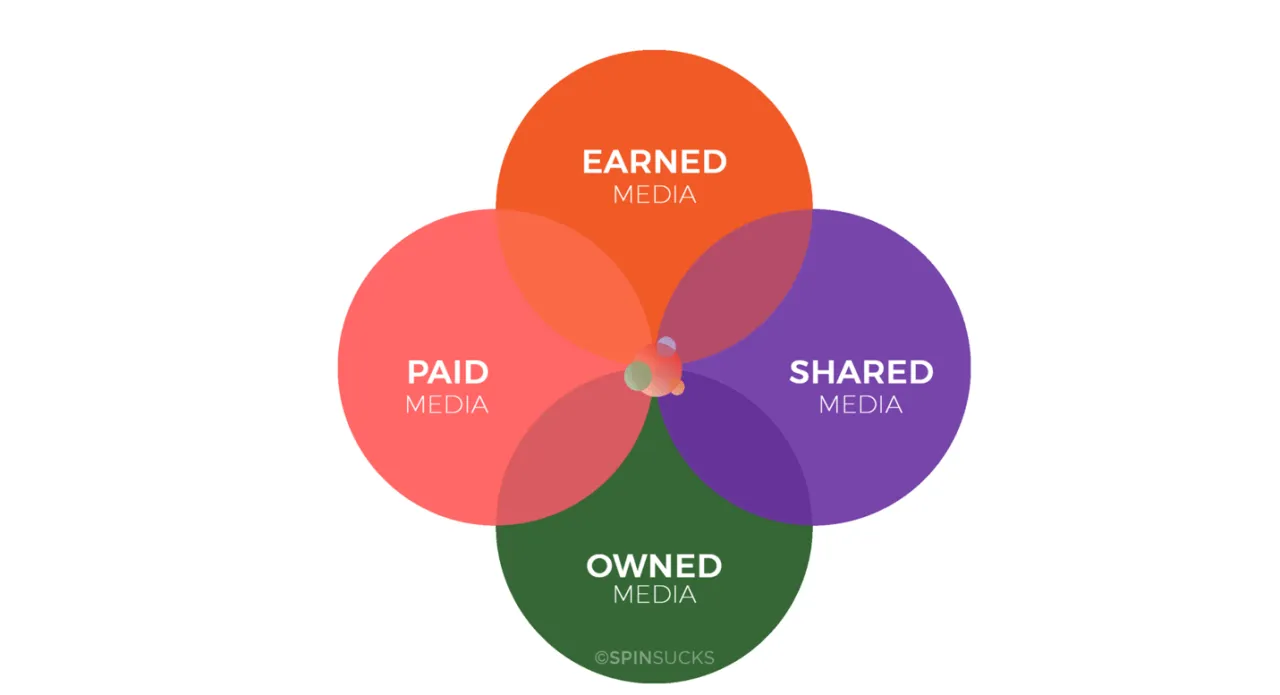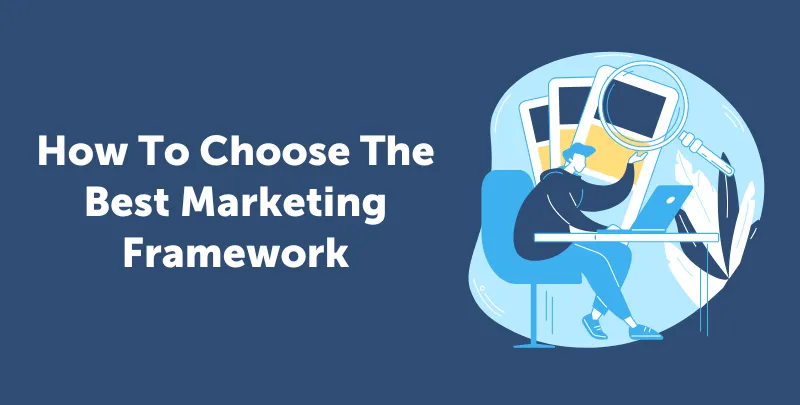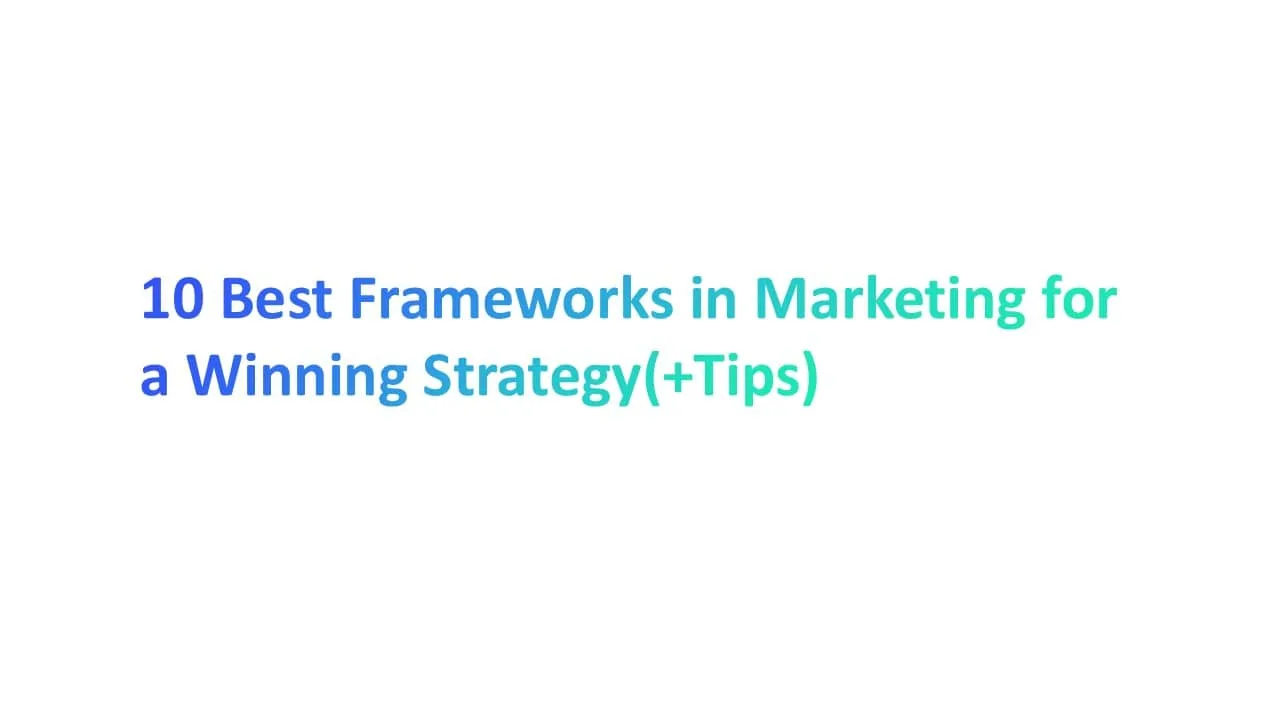Implementing effective marketing frameworks is essential for crafting a successful marketing strategy. These structured approaches guide your marketing efforts, ensuring alignment with your business objectives and target audience.
According to Salesforce, a marketing framework helps you measure and evaluate the success of your marketing activities more easily by establishing key metrics and key performance indicators (KPIs).
In this article, we'll explore the top 10 marketing frameworks and provide practical tips to enhance your marketing campaigns.
What is a Marketing Framework?

A marketing framework is a structured approach that helps businesses create, execute, and refine their marketing strategy framework effectively. It provides a clear roadmap for reaching target customers through marketing channels, guiding decisions on pricing strategy, customer engagement, and market penetration.
Businesses use different strategy frameworks to align their efforts with business goals and industry market trends. Whether applying the blue ocean strategy to create uncontested market space or using a unique value proposition to attract new customers, the right framework ensures informed decisions and sustainable growth.
Strong marketing initiatives and strategic planning help businesses navigate competitive environments and seize growth opportunities.
How Do Frameworks in Marketing Improve Your Marketing Strategy?

A well-structured marketing strategy framework helps businesses make informed choices, streamline processes, and drive measurable results.
Using the right marketing frameworks focus allows brands to develop structured plans, identify growth areas, and align their efforts with long-term goals.
Here’s how frameworks contribute to a more effective strategy.
1. Enhances Decision-Making
A structured strategy framework simplifies decision-making by offering clear guidelines. Instead of relying on intuition, businesses can use data-driven models to evaluate external factors and market conditions.
For instance, understanding bargaining power of suppliers helps in pricing decisions, while analyzing competitive rivalry offers insights into positioning.
A well-defined framework ensures that every choice is backed by analysis rather than guesswork.
2. Creates a Clear Marketing Roadmap
Frameworks provide a roadmap that aligns with business objectives. A strong overall marketing strategy ensures that businesses stay on track while adapting to market shifts.
Whether it’s expanding into new markets, refining a digital marketing strategy, or implementing growth strategies, a structured approach ensures every step is deliberate.
Planning around four growth strategies, market penetration, product development, market development, and diversification, helps in identifying the best path for expansion.
3. Aligns Goals with Strategy
Aligning a marketing strategy framework with business goals ensures consistent efforts across all departments.
A successful plan factors in marketing mix elements, product positioning, and distribution channels to create an integrated approach.
Businesses looking to scale into existing markets or explore digital marketing planning can refine their strategy based on defined objectives.
The right framework ensures that every marketing effort contributes to measurable outcomes.
4. Improves Audience Targeting
Understanding consumer behavior and engagement patterns helps brands reach the right audience.
A framework like customer journey mapping enables businesses to refine targeting strategies.
Whether it’s through social media marketing, paid advertising, or personalized content, structuring campaigns around a strategic marketing framework ensures better engagement.
Businesses that focus on providing exceptional customer service also build long-term loyalty and trust.
5. Measures Performance Effectively
A strong marketing framework models performance through key indicators like conversion rates, engagement levels, and revenue growth.
Tracking marketing messages across platforms helps businesses refine their approach. Data-driven models allow for adjustments based on feedback, ensuring that marketing efforts remain effective.
Whether evaluating customer feedback or adjusting to external factors, businesses gain a clearer picture of what works.
6. Streamlines Campaign Execution
Efficient execution relies on well-structured frameworks that integrate every aspect of marketing efforts.
A refined digital marketing frameworks approach ensures that campaigns are aligned with broader business goals.
Using essential tools for automation and analytics simplifies execution, reducing errors and improving outcomes.
This structured approach ensures that campaigns are launched on time and deliver consistent results.
7. Ensures Consistency Across Channels
Consistency is key to maintaining brand identity and trust. A strong marketing team follows an organized framework to ensure uniform messaging across platforms.
Whether implementing a digital marketing strategy framework or adjusting for competitive rivalry, structured guidelines help businesses maintain coherence.
A consistent strategy, backed by effective marketing strategies, reinforces brand credibility and improves customer retention.
Using the right marketing frameworks focus helps businesses make smarter decisions, execute campaigns efficiently, and engage customers effectively. Whether expanding into new markets, refining digital marketing planning, or improving customer loyalty, structured models provide a reliable approach to success.
With clear objectives, performance tracking, and market insights, businesses can ensure sustained growth and adaptability in changing conditions.
10 Best Frameworks in Marketing for a Winning Strategy

Marketing frameworks help businesses make informed decisions, structure campaigns, and improve customer engagement.
By applying the right framework, companies can ensure their marketing efforts align with business objectives and deliver measurable results.
Below are the 10 most effective marketing frameworks, each playing a crucial role in building a winning strategy.
1. 4Ps of Marketing
The 4Ps of marketing—Product, Price, Place, and Promotion—form the foundation of any marketing plan.
This model helps businesses define their product or service positioning and ensure they reach the right audience effectively.
- Product: Focus on product features, quality, and differentiation.
- Price: Set competitive pricing by evaluating buyer power and perceived value.
- Place: Choose the best distribution channels for potential customers and existing customers.
- Promotion: Use advertising, PR, and digital strategies to create awareness.
Why the 4Ps Matter
- Provides a structured approach for defining the marketing framework models.
- Ensures strategic thinking in pricing, distribution, and brand communication.
- Helps businesses achieve business success by improving sales and market presence.
2. STP Model
The Segmentation, Targeting, and Positioning (STP) Model allows businesses to refine their audience segmentation and develop targeted marketing efforts.
- Segmentation: Divide the market based on demographics, behaviors, and interests.
- Targeting: Identify the most valuable potential customers for the brand.
- Positioning: Craft a unique value proposition that differentiates the product from competitors.
Benefits of STP Model
- Enhances personalization in marketing campaigns.
- Ensures informed decisions in audience selection.
- Strengthens engagement with customer lifetime value strategies.
3. AIDA Model
The AIDA Model (Awareness, Interest, Desire, Action) describes how customers move through the decision-making process before purchasing a product or service.
- Awareness: Capture attention through advertising and content marketing.
- Interest: Engage potential customers with compelling information.
- Desire: Build emotional connections to create demand.
- Action: Guide the customer toward making a purchase.
How AIDA Helps Marketing Efforts
- Improves brand visibility and customer engagement.
- Aligns with marketing framework models to optimize conversions.
- Helps enhance customer lifetime value.
4. SWOT Analysis
SWOT Analysis (Strengths, Weaknesses, Opportunities, Threats) is a powerful tool for assessing a company’s position in the market.
- Strengths: Unique advantages such as product quality or brand recognition.
- Weaknesses: Areas where the business can improve, such as pricing or customer service.
- Opportunities: Growth opportunities in new or existing markets.
- Threats: External factors like competition or market changes.
Why SWOT Analysis Is Essential
- Helps with strategic thinking in decision-making.
- Identifies opportunities for marketing initiatives.
- Ensures businesses stay competitive by adjusting to market conditions.
5. Porter’s Five Forces Model
Porter’s Five Forces Model helps businesses understand their competitive environment by evaluating market conditions.
- Bargaining power of suppliers: Influence suppliers have on costs and supply chains.
- Bargaining power of buyers: How easily potential customers can switch brands.
- Threat of new entrants: The risk of new competitors entering the market.
- Threat of substitutes: The availability of alternative products.
- Competitive rivalry: The intensity of competition within the industry.
How Porter’s Model Strengthens Strategy
- Guides market penetration and pricing decisions.
- Helps businesses create a strong unique value proposition.
- Provides insights for business success in competitive industries.
6. PESO Model

The PESO Model categorizes marketing efforts into Paid, Earned, Shared, and Owned media.
- Paid Media: Digital ads, influencer partnerships, and sponsored content.
- Earned Media: PR mentions, media coverage, and customer reviews.
- Shared Media: Social media engagement and partnerships.
- Owned Media: Blogs, websites, and newsletters.
Why PESO Works for Digital Marketing
- Optimizes digital marketing planning across channels.
- Improves brand awareness through multiple touchpoints.
- Strengthens customer engagement through content and social media.
7. Ansoff Matrix
The Ansoff Matrix helps businesses develop structured growth opportunities by focusing on four key strategies:
- Market Penetration: Expanding sales in existing markets through promotions or loyalty programs.
- Market Development: Introducing products to new markets and demographics.
- Product Development: Creating new offerings for existing customers.
- Diversification: Entering new markets with brand-new products.
How Ansoff Matrix Supports Growth
- Helps evaluate business success strategies.
- Reduces risk by aligning expansion efforts with informed decisions.
- Encourages businesses to explore marketing initiatives for expansion.
8. Growth Hacking Framework
The Growth Hacking Framework focuses on quick, scalable marketing techniques to achieve rapid growth.
- Identify key growth drivers using data insights.
- Experiment with digital marketing tactics such as A/B testing.
- Measure and optimize continuously for best performance.
Why Growth Hacking Works
- Helps businesses expand with minimal resources.
- Improves adaptability in marketing efforts.
- Ensures rapid customer engagement and conversion.
9. Customer Journey Mapping
A customer journey map helps businesses understand how customers interact with a brand.
- Awareness: How customers first discover the business.
- Consideration: Research phase where they compare options.
- Decision: The point where a customer makes a purchase.
- Retention: Post-purchase strategies to improve customer lifetime value.
How Journey Mapping Helps Businesses
- Enhances exceptional customer service by identifying pain points.
- Improves retention strategies for existing customers.
- Provides insights into potential customers’ needs and behaviors.
10. Value Proposition Canvas
The Value Proposition Canvas ensures that a company’s products meet customer needs.
- Customer Profile: Defines pain points, goals, and expectations.
- Value Proposition: Explains how the product or service provides solutions.
- Product Fit: Ensures offerings align with market demand.
Why Value Proposition Matters
- Helps refine marketing initiatives and messaging.
- Strengthens positioning in competitive environments.
- Ensures businesses provide genuine value to potential customers.
Applying the right marketing framework models helps businesses create structured, goal-driven marketing efforts.
These frameworks provide a powerful tool to optimize customer engagement, increase business success, and identify growth opportunities.
By implementing these models, businesses can build effective marketing strategies that drive sustainable results.
How to Choose the Right Framework Based on Goals?

Choosing the right strategy framework is essential for effective marketing planning. Different businesses have unique needs, and using the wrong model can lead to poor results.
A well-structured framework helps streamline efforts, align strategies with goals, and improve decision-making.
Below are seven steps to select the right framework and apply it effectively.
1. Identify Your Business Objectives
Every business needs a clear understanding of what it wants to achieve before selecting a framework.
Whether the goal is increasing revenue, expanding into new markets, or enhancing customer lifecycle management, defining objectives helps narrow down the best approach.
How to do it
- List short-term and long-term business goals.
- Identify challenges that might slow down growth.
- Consider if the focus is on customer acquisition, retention, or expansion.
- Align frameworks with core company values and mission.
2. Understand Your Target Audience
A marketing strategy will only be effective if it aligns with the needs of the target customers.
A deep understanding of customer lifecycle stages, behaviors, and preferences helps in choosing a framework that ensures better engagement and retention.
How to do it
- Conduct surveys and gather customer feedback to learn about their needs.
- Analyze purchase behaviors and interaction history.
- Segment the audience based on demographics, preferences, and buying patterns.
- Use insights to select frameworks that align with audience expectations.
3. Match Frameworks to Marketing Needs
Not all frameworks fit every business. A startup expanding into new markets might need an Ansoff Matrix, while an established business may benefit from SWOT Analysis for improving physical evidence and branding.
How to do it
- Compare different frameworks and their key benefits.
- Choose a model that best fits the company’s marketing initiatives.
- Consider whether the business needs a structured approach or a flexible one.
- Align frameworks with business goals and audience engagement strategies.
4. Evaluate Data-Driven Insights
Marketing decisions should be based on real data rather than assumptions. A data-backed strategy framework ensures better planning, execution, and performance tracking.
How to do it
- Collect and analyze customer and sales data to identify trends.
- Use historical data to determine what has worked before.
- Implement best marketing frameworks that allow for measurable results.
- Track engagement levels to understand the effectiveness of different strategies.
5. Consider Industry and Competition
Analyzing the competitive environment is essential for selecting the right framework. Different industries have different marketing needs, and understanding competition helps businesses stay relevant and effective.
How to do it
- Study competitors’ strategies and marketing approaches.
- Identify industry standards and best practices.
- Use SWOT Analysis to evaluate strengths and weaknesses.
- Choose frameworks that help differentiate the brand in new markets.
6. Test and Refine Your Approach
No marketing framework is perfect from the start. Testing and refining are key to ensuring that the selected framework meets business goals.
How to do it
- Implement a framework on a small scale before full deployment.
- Gather customer feedback to see what resonates.
- Track key performance indicators (KPIs) to measure success.
- Adjust strategies based on real-world results.
7. Adapt Frameworks as Goals Evolve
Business needs change over time, and frameworks should evolve accordingly. Whether expanding to new markets or improving customer lifecycle management, adapting ensures sustained success.
How to do it
- Regularly review business performance and strategy alignment.
- Be open to switching frameworks if the current one no longer meets needs.
- Integrate best marketing frameworks to refine existing strategies.
- Stay updated on industry trends and adjust accordingly.
Selecting the right strategy framework requires a structured approach, considering business goals, audience, industry, and data insights.
By following these steps, businesses can ensure that their marketing initiatives align with their long-term success while keeping up with evolving market demands.
How to Apply These Marketing Frameworks for Success?

A marketing framework provides structure, but applying it effectively determines its success. It must be integrated into your strategy, tested, and refined for optimal results.
Below are 10 essential steps to apply marketing frameworks properly, ensuring they drive growth and engagement.
1. Define Your Marketing Goals
A framework is only effective when applied to clear objectives. Defining precise marketing goals ensures that the strategy stays focused and results-driven.
Steps to Follow:
- Outline both short-term and long-term marketing goals.
- Ensure goals are measurable, realistic, and time-bound.
- Identify the key performance indicators (KPIs) that define success.
- Align goals with broader business objectives to ensure consistency.
Why Goal Clarity is Important?
- Helps in choosing the most suitable marketing framework.
- Ensures marketing efforts contribute to the company’s overall success.
- Reduces wasted resources on strategies that don’t align with business needs.
2. Choose the Right Framework
Not all frameworks suit every business or situation. Selecting the right one ensures efficiency and better outcomes.
Steps to Follow:
- Research different frameworks and their practical applications.
- Compare frameworks based on their focus, such as audience engagement, market positioning, or branding.
- Consider scalability – can the framework grow with your business?
- Test previous marketing efforts to determine which framework aligns best.
How the Right Framework Impacts Marketing?
- Increases marketing efficiency by aligning efforts with business goals.
- Reduces confusion by providing a clear direction.
- Helps teams execute strategies with confidence.
3. Break It Into Actionable Steps
A framework is just a guide—it needs to be translated into specific tasks that can be executed effectively.
Steps to Follow:
- Identify the core components of the chosen framework.
- Break down each component into tasks for different teams.
- Set timelines and milestones to track execution.
- Ensure every step contributes to the overall marketing strategy.
How Actionable Steps Improve Execution?
- Allows teams to understand their responsibilities.
- Prevents bottlenecks by breaking down large projects into manageable tasks.
- Creates a structured roadmap, ensuring consistency across teams.
4. Align It With Your Strategy
A marketing framework should enhance existing efforts rather than disrupt them.
Steps to Follow:
- Integrate the framework into existing marketing initiatives.
- Ensure it complements other business strategies.
- Communicate the new framework across departments for seamless alignment.
- Adjust branding, messaging, and workflows to fit the framework.
Why Alignment is Crucial?
- Maintains brand consistency across different channels.
- Prevents conflicts between marketing strategies and business objectives.
- Helps teams work towards unified goals.
5. Implement It Across Channels
For a framework to be effective, it must be applied consistently across all marketing channels.
Steps to Follow:
- Adapt the framework for digital, offline, and social media marketing.
- Ensure messaging remains consistent and engaging across platforms.
- Train teams to implement the framework correctly.
- Use automation tools where possible to streamline execution.
Why Multi-Channel Implementation Matters?
- Expands reach and increases engagement.
- Reinforces brand identity and strengthens customer trust.
- Creates a seamless experience for consumers across platforms.
6. Use Data to Track Progress

Measuring results ensures that the marketing framework is delivering the expected impact.
Steps to Follow:
- Set up tracking systems for all marketing efforts.
- Use analytics tools to measure engagement, conversions, and trends.
- Compare results with predefined KPIs to assess performance.
- Adjust strategy based on real-time data insights.
How Data Improves Framework Efficiency?
- Provides evidence of what works and what doesn’t.
- Helps refine strategies to improve overall effectiveness.
- Ensures continuous improvement by identifying trends and patterns.
7. Identify Areas for Improvement
Marketing strategies should always evolve based on performance and audience response.
Steps to Follow:
- Gather insights from customer feedback and performance reports.
- Monitor which parts of the framework are underperforming.
- Identify gaps in engagement, messaging, or conversion rates.
- Compare results with industry benchmarks to measure competitiveness.
Why Continuous Improvement is Necessary?
- Ensures that strategies stay relevant in changing market conditions.
- Helps businesses adapt to audience preferences.
- Leads to better decision-making for future campaigns.
8. Optimize Based on Insights
Once weak points are identified, adjustments should be made to improve marketing effectiveness.
Steps to Follow:
- Modify content, targeting, or budget allocation based on data insights.
- Optimize underperforming channels rather than discarding them completely.
- Experiment with different audience segments and messaging approaches.
- Regularly update marketing plans to align with new business priorities.
Why Optimization Matters?
- Improves marketing ROI by making campaigns more effective.
- Ensures marketing efforts evolve with industry trends.
- Reduces inefficiencies, maximizing the impact of every campaign.
9. Test Different Approaches
Marketing is not static. Testing new methods helps businesses refine strategies and increase engagement.
Steps to Follow:
- Run A/B tests on different marketing messages, formats, and platforms.
- Experiment with different ad placements, call-to-actions, and content styles.
- Monitor how different approaches affect audience engagement.
- Use test results to guide future marketing decisions.
How Testing Improves Strategy?
- Helps identify the most effective marketing tactics.
- Reduces guesswork and ensures data-backed decisions.
- Enhances adaptability by providing multiple approaches to success.
10. Adapt as Your Business Grows
What works today may not work in the future. Businesses need to adjust their frameworks as they scale.
Steps to Follow:
- Regularly assess marketing performance against business goals.
- Adapt strategies based on changes in customer behavior and market conditions.
- Stay open to integrating new frameworks when needed.
- Invest in continuous learning to keep up with evolving marketing trends.
Why Adaptability is Key?
- Ensures businesses remain competitive.
- Helps companies cater to new customer segments.
- Prevents marketing efforts from becoming outdated.
Applying a marketing framework successfully requires careful planning, execution, and continuous refinement.
By following these ten steps, businesses can ensure that their chosen framework remains effective, aligns with business objectives, and adapts to changing conditions.
Consistency, data-driven decisions, and flexibility are key to long-term marketing success.
How Does Digital Marketing Benefit from These Frameworks?

Digital marketing frameworks provide businesses with a structured approach to managing campaigns, reaching the right audience, and optimizing performance.
By using these frameworks, companies can improve their strategy, enhance customer engagement, and track success more effectively.
Below are eight ways digital marketing benefits from structured frameworks.
1. Structuring Campaigns
A well-defined framework helps businesses plan and execute digital campaigns more efficiently.
Instead of taking an unorganized approach, companies can align their efforts with clear objectives, ensuring consistency and better results.
How It Helps:
- Provides a roadmap for campaign execution.
- Ensures messaging remains consistent across all digital channels.
- Helps allocate resources effectively, preventing wasted effort.
- Aligns campaign goals with business priorities.
2. Improving Audience Targeting
Reaching the right audience is essential for digital marketing success. A structured framework allows businesses to define their ideal customers and tailor their approach accordingly.
How It Helps:
- Segments audiences based on behavior, demographics, and interests.
- Refines targeting to ensure ads and content reach the most relevant users.
- Improves engagement by delivering personalized experiences.
- Reduces marketing spend on audiences that are unlikely to convert.
3. Enhancing Content Strategy
Content plays a major role in digital marketing, and a structured framework helps businesses create relevant, high-quality content that resonates with their audience.
How It Helps:
- Guides content planning, ensuring consistency in messaging.
- Helps identify key topics that align with audience interests.
- Improves content distribution across digital channels.
- Ensures that content supports broader marketing goals.
4. Optimizing Ad Spend
A structured approach to advertising ensures businesses get the most value from their marketing budget. With the right framework, ad campaigns can be adjusted for maximum efficiency.
How It Helps:
- Prevents unnecessary spending on underperforming ads.
- Identifies the best-performing platforms and channels.
- Adjusts ad placements based on real-time performance data.
- Ensures return on investment (ROI) is maximized.
5. Improving SEO Performance
Search engine optimization (SEO) is crucial for increasing website visibility. A structured framework ensures SEO efforts are aligned with business goals and digital marketing strategies.
How It Helps:
- Helps organize keyword research and content optimization.
- Ensures SEO best practices are followed across all digital assets.
- Improves website structure, enhancing user experience.
- Provides a long-term approach to ranking higher in search results.
6. Personalizing Customer Journeys
A marketing framework allows businesses to map out and personalize customer experiences at different touchpoints, improving engagement and conversions.
How It Helps:
- Tracks customer interactions and tailors messaging accordingly.
- Creates personalized content based on user behavior.
- Helps businesses automate follow-up strategies to keep customers engaged.
- Ensures a smooth transition from awareness to conversion.
7. Automating Marketing Tasks
Automation improves efficiency by handling repetitive tasks, allowing businesses to focus on strategic planning and customer relationships.
How It Helps:
- Reduces manual effort in managing email campaigns and social media posts.
- Ensures consistency in customer communication.
- Helps scale marketing efforts without increasing workload.
- Improves response time, enhancing customer satisfaction.
8. Measuring Digital Success
Tracking performance is essential for refining marketing efforts. A structured framework ensures businesses measure success using relevant data and insights.
How It Helps:
- Provides clear metrics to assess campaign performance.
- Identifies areas where improvements are needed.
- Helps businesses make data-driven decisions.
- Ensures digital marketing strategies remain effective over time.
Digital marketing frameworks offer a structured way to manage campaigns, improve targeting, and optimize performance.
By applying these frameworks, businesses can enhance their marketing efforts, ensure consistency, and achieve better results.
Expert Tips to Get the Most Out of Marketing Frameworks

Marketing frameworks help businesses create structured strategies, but their effectiveness depends on how they are applied.
A rigid or overly complex framework can slow down progress, while a well-adapted one can improve decision-making and execution.
Below are eight expert tips to maximize the value of marketing frameworks.
1. Keep It Simple and Flexible
A marketing framework should provide structure without becoming restrictive. Complex models can slow down execution, while a flexible approach allows businesses to adjust strategies based on real-time insights.
Making Frameworks Workable
- Avoid overcomplicating with unnecessary steps.
- Keep the framework adaptable to different scenarios.
- Focus on essential elements that drive results.
- Ensure all team members can easily understand and apply it.
2. Combine Multiple Frameworks
No single framework covers all aspects of marketing. Combining models allows businesses to leverage different strengths and create a more comprehensive strategy.
Blending Different Approaches
- Use one framework for audience segmentation and another for content strategy.
- Combine data-driven models with creative planning techniques.
- Apply performance measurement frameworks alongside campaign execution models.
- Ensure frameworks complement each other rather than conflicting.
3. Align Teams with Strategy
A framework is only effective if everyone involved understands and follows it. Aligning teams with the strategy ensures consistency and smooth execution.
Ensuring Team Collaboration
- Communicate the framework clearly across departments.
- Provide training sessions to ensure understanding.
- Set measurable objectives that align with team responsibilities.
- Encourage cross-functional collaboration for better execution.
4. Validate with Real Data
Marketing strategies should be based on real-world data, not assumptions. Using data-driven insights helps refine frameworks and improve their effectiveness.
Using Data to Improve Frameworks
- Track campaign performance through analytics.
- Use customer insights to refine audience targeting.
- Test different messaging approaches before scaling efforts.
- Adjust marketing efforts based on measurable results.
5. Stay Updated on Trends
Marketing frameworks must evolve with industry changes. Keeping up with trends ensures strategies remain relevant and effective.
Adapting to Market Changes
- Monitor emerging marketing techniques and innovations.
- Analyze competitor strategies to identify shifts in consumer behavior.
- Update frameworks to incorporate new tools and technologies.
- Regularly review and refine strategies based on industry developments.
6. Automate for Efficiency
Automation tools streamline marketing processes and improve consistency. Integrating automation within a framework helps save time and enhance productivity.
Improving Workflow with Automation
- Use AI-driven tools for data analysis and reporting.
- Automate email campaigns to maintain customer engagement.
- Schedule social media posts for consistent brand visibility.
- Leverage automation for lead generation and follow-ups.
7. Adapt Frameworks to Market Shifts
Markets change, and frameworks should adjust accordingly. Businesses that adapt quickly stay ahead of competition and respond effectively to new challenges.
Staying Agile in Marketing
- Regularly assess framework effectiveness and make necessary updates.
- Shift strategies based on consumer behavior and demand.
- Experiment with different approaches to identify what works best.
- Be open to replacing outdated models with newer, more relevant ones.
8. Customize Frameworks for Your Industry
Not all marketing frameworks fit every business. Customizing models based on industry needs ensures better alignment with business objectives.
Tailoring Frameworks to Business Needs
- Modify existing frameworks to suit industry-specific challenges.
- Focus on key factors that drive success in your sector.
- Incorporate feedback from industry experts and customers.
- Avoid a one-size-fits-all approach by refining frameworks for unique goals.
Marketing frameworks are tools that should evolve with business needs. Keeping them simple, data-driven, and adaptable ensures they remain effective.
By applying these expert tips, businesses can optimize their marketing strategies and achieve long-term success.
Common Mistakes to Avoid

Marketing frameworks help businesses streamline their strategies, but using them incorrectly can lead to ineffective campaigns, wasted resources, and missed opportunities.
Many businesses fall into the same traps when implementing marketing frameworks. Below are eight common mistakes and how to avoid them to ensure better marketing outcomes.
1. Picking the Wrong Framework
Not every marketing framework fits every business. Choosing a framework without considering business goals, industry needs, or customer behavior can lead to wasted time and effort.
How to Avoid It
- Assess business objectives before selecting a framework.
- Research different frameworks and their applications.
- Choose a flexible model that can adapt to changing needs.
- Test the framework on a small scale before full implementation.
2. Ignoring Market Trends
Marketing strategies must evolve with consumer behavior and industry changes. Ignoring trends can lead to outdated approaches that fail to engage audiences.
How to Avoid It
- Stay informed about emerging marketing trends and customer preferences.
- Analyze competitors to identify shifts in industry strategies.
- Adapt frameworks to incorporate new tools and technologies.
- Regularly review and refine marketing approaches to stay relevant.
3. Overcomplicating the Process
Some businesses make their marketing frameworks too complex, adding unnecessary layers of strategy that slow down execution and create confusion.
How to Avoid It
- Focus on the essential elements of a framework.
- Keep steps clear and easy to follow.
- Ensure every process contributes directly to marketing objectives.
- Train teams on simplified processes to improve efficiency.
4. Not Tracking Performance
Without measuring performance, businesses can’t determine whether their framework is working. This can lead to repeated mistakes and lost opportunities.
How to Avoid It
- Set measurable goals and track key performance indicators (KPIs).
- Use analytics tools to monitor campaign results.
- Adjust strategies based on data insights rather than assumptions.
- Review performance regularly to refine and improve approaches.
5. Relying on One Framework
Using a single framework limits flexibility. Businesses that don’t explore other models might miss opportunities to improve engagement, reach, and conversions.
How to Avoid It
- Combine different frameworks that complement each other.
- Experiment with alternative strategies to find what works best.
- Stay open to adapting frameworks as business needs change.
- Align frameworks with specific campaign objectives for better results.
6. Misaligning Strategy and Execution
A well-structured marketing framework is useless if execution doesn’t align with the strategy. Many businesses plan well but fail in implementation.
How to Avoid It
- Ensure teams understand the framework and their role in executing it.
- Communicate clear objectives and provide step-by-step guidance.
- Keep execution teams involved in the strategy development process.
- Regularly check for inconsistencies between strategy and execution.
7. Skipping Audience Research
Marketing frameworks are designed to improve targeting, but failing to research the audience results in ineffective messaging and poor engagement.
How to Avoid It
- Conduct detailed audience research before launching a campaign.
- Use surveys, customer data, and market insights to refine targeting.
- Segment the audience to personalize marketing efforts.
- Continuously update customer insights to align with evolving preferences.
8. Lacking Team Collaboration
Marketing frameworks involve multiple departments, and poor communication between teams can lead to misalignment and inefficiency.
How to Avoid It
- Foster collaboration between marketing, sales, and customer service teams.
- Hold regular meetings to ensure alignment and discuss challenges.
- Use shared tools and dashboards to improve communication.
- Encourage feedback and continuous improvement across teams.
Avoiding these mistakes helps businesses get the most out of marketing frameworks. Keeping strategies adaptable, tracking performance, and ensuring collaboration across teams leads to more effective marketing efforts and better results.
Conclusion
Mastering the right marketing frameworks can transform your strategy and lead to greater success. With a clear understanding of your goals, audience, and market trends, you can choose and apply frameworks that align with your business needs.
Remember to keep things simple, stay flexible, and always validate your efforts with real data. Whether you’re structuring campaigns, optimizing ad spend, or enhancing customer journeys, these frameworks offer a roadmap to smarter marketing decisions.
By avoiding common mistakes and following expert tips, you can make the most of these tools and create a winning strategy. Ready to explore the best frameworks in marketing?





.jpg)

.jpg)
